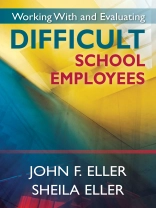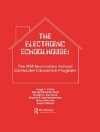‘The Ellers have done an excellent job identifying supervision problems that plague administrators on a daily basis. They provide clear and detailed strategies to address personnel problems covering virtually every employment group. I strongly recommend this book as a quick reference for all school administrators as they deal with difficult employees.’
—Dan Hoverman, Superintendent
Mounds View Public Schools, Shoreview, MN
Help marginal employees take positive steps to improve their performance and behavior!
Managing difficult employees is one of the most challenging aspects of a school leader′s job. Written by experienced administrators, this resource provides specific techniques and strategies to identify, work with, and evaluate marginal school employees.
John F. Eller and Sheila Eller provide essential information for understanding and dealing with employees who may have negative attitudes, lack awareness of their behavior, blame others for problems, or are marginal performers. Drawing on the authors′ extensive experience, this book includes:
- Skills and sample dialogues for conducting difficult conversations
- Templates for putting concerns into writing and developing improvement plans
- Information about legal issues and ways to protect yourself
- Specific strategies for working with teachers, secretaries and assistants, paraprofessionals, and custodial staff
- Steps to take when termination becomes necessary
This ready reference helps administrators develop the leadership skills and competencies necessary to confront marginal and deficient behaviors and achieve successful results.
Daftar Isi
Preface
About the Authors
1. The Nature of Difficult/Marginal Employees: Why Don′t These People Listen to Reason and Improve?
Frames of Reference
Characteristics of Difficult Employees
The Response to Change
Understanding the Source of the Difficulty
Summary
2. What Skills and Tools Do I Need in Order to Take On This Situation?
Background of Employee Discipline
A Competencies-Based Approach to Thinking About Employee Problems
The Definition of Success When Working With Difficult or Deficient Employees
Your Readiness in Dealing With a Difficult Situation or Person
The Use of Job Descriptions in Your Work With Difficult School Employees
Summary
3. Strategies for Confronting Marginal and Deficient Behaviors
Framing
Authority Voice
Summary
4. Protecting Yourself While Dealing With Difficult Employees
Presuppositions
Reflecting
Displacing Negative Energy
Additional Self-Protection Strategies
Summary
5. Strategies for Working With Difficult/Marginal Teachers
The Law and Teacher Employment
Your Master Contract or Master Agreement
Understanding Your Evaluation Criteria
The Ability to Describe Deficient or Substandard Work
Base and Surface Competancies
Deciding Whether to Move Forward to Terminate Employment or Develop a Growth Plan
Growth Plans
Delivering a Deficiency Notice or Termination Message to a Teacher
The Entire Cycle
Summary
6. Strategies for Working with Difficult/Marginal Secretaries and Office
Handling Your Administrative Assistants
A Basic Set of Administrative Assistant/Office Employee Tasks
Base and Surface Competancies
Prioritizing Work Tasks
Planning Sessions to Establish Priorities for the Work Completion
Growth Plans
Delivering a Deficiency Notice or Termination Message to an Administrative Assistant
Summary
7. Strategies for Working with Difficult/Marginal Paraprofessionals and Teaching Assistants
The Nature of Teaching Assistants and Paraprofessionals
Base and Surface Competancies
Growth Plans
Delivering a Performance Concern or Termination Message to a Paraprofessional or Teaching Assistant
An Example of a Meeting and Letter of Reprimand for a Paraprofessional
Summary
8. Strategies for Working with Difficult/Marginal Custodians
Possible Difficult Custodial Behaviors
Effective Delegation of Tasks and Assignments
Base and Surface Competancies
Growth Plans
Delivering a Performance or Skill Deficit Concern to a Custodial Employee
Summary
References
Index
Tentang Penulis
Sheila Eller has worked in a multitude of educational settings during her career. In addition to her current position as a principal in the Fairfax County Virginia Public Schools, she has served as a middle school principal in the Moundsview Minnesota School District, as a principal in other schools in Minnesota and Illinois, as a university professor, as a Special Education Teacher, a Title I Math Teacher, and a self-contained classroom teacher in grades 1-4. Sheila has also been a member of the Executive Board of Minnesota ASCD and has been a regional president of the Minnesota Association of Elementary School Principals. She has advanced coursework in educational administration and supervision from St. Cloud State University, her Master’s Degree from Creighton University in Omaha, Nebraska, and a Bachelors Degree from Iowa State University. Sheila is a regular presenter at the ASCD National Conventions sharing her expertise on the topic of effective staff meetings and multiage instruction. While she served as a professor at National-Louis University in Evanston Illinois, she worked on the development team for a classroom mathematics series that was adopted by several districts in the region. Her classroom and instructional techniques were featured on a video that was produced as a complement to this series. She works with educators in developing energized staff meetings, school improvement initiatives, multiage teaching strategies, employee supervision, and other teaching and learning content areas. In addition to this book, Sheila co-authored the best-selling Energizing Staff Meetings and Creative Strategies to Improve School Climate. through Corwin Press.












